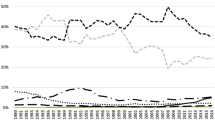Abstract
While there are a number of theoretical arguments in favour of capital account convertibility, or free cross-border capital mobility, in the real world cross-border trade in financial assets can in fact reduce welfare due to the effects of domestic distortions. The following paper examines the causes of the Asian financial crises of the late 1990s in this light and presents some of the lessons that would be instructive for a more effective implementation of capital account convertibility.
Similar content being viewed by others
References
R. Solow: A Contribution to the Theory of Economic Growth, in: Quarterly Journal of Economics, February 1956, pp. 65–94.
P. Krugman: A model of balance of payments crises, in: Journal of Money, Credid and Banking, Vol. 11, 1998, pp. 311–325.
J. Tobin: A Proposal for International Monetary Reform, in: Eastern Economic Journal, Vol. 4, 1978, pp. 153–59.
J. Tobin: Prologue, in: M. ul Haque, I. Kaul and I. Grunberg (eds.): The Tobin Tax: Coping with Financial Volatility. Oxford University Press 1996, pp. xiv–xviii.
J. Frankel: How Well Do Foreign Exchange Markets Function: Might A Tobin Tax Help?, NBER Working Paper No. 5422, 1996.
S. Fischer: Reforming the international Financial System, in: Economic Journal, Vol. 109, November 1999, pp. F557–567.
World Bank: The East Asian Miracle: Economic Growth and Public Policy, New York 1993, Oxford University Press.
M. Obstfeld and K. Rogoff: Foundations of International Finance, 1996, MIT Press.
J. Bhagwati: The Capital Myth: The Difference Between Trade in Widgets and Trade in Dollars, in: Foreign Affairs, Vol. 77, 1998, pp. 7–12; R. N. Cooper: Should capital account convertibility be a world objective? in: Should the IMF pursue Capital Account Convertibility: Essays in International Finance, No. 207, Princeton 1998, Princeton University.
M. P. Dooley: A survey of the literature on controls over international capital transacations: in: International Monetary Fund Staff Papers, Vol. 43, 1996, pp. 639–87.
S. Fischer: Capital account liberalization and the role of the IMF. in: Should the IMF Pursue Capital Account Convertibility, op. cit..
B. Eichengreen et al.: Capital Account Liberalisation. Theoretical and Practical Aspects, Occasional Paper 172, International Monetary Fund, Washington DC 1999.
M. Obstfeld: Models of currency crises with selffulfilling features, in: European Economic Review, Vol. 40, 1996, pp. 1037–1047,
M. P. Dooley, op. cit. A survey of the literature on controls over international capital transacations, in: International Monetary Fund Staff Papers, Vol. 43, 1996, pp. 639–87.
S. Fischer, op. cit..
R. McKinnon: The Order of Economic Liberalization: Lessons from Chile and Argentina, in: K. Brunner and A. Meltzer (eds.): Economic Policy in a World of Change, Carnegie-Rochester Conference Series on Public Policy. Amsterdam 1982, North-Holland, pp. 159–71.
D. J. Mathieson and L. Rojas-Suarez: Liberalization of the Capital Account. Experiences and Issues, in: International Monetary Fund: Occassional Paper No. 103. Washington, DC 1993.
D. Rodrik: Who Needs Capital-Account Convertibility, in: Should the IMF Pursue Capital Account Convertibility op. cit., Princeton 1998, Princeton University. pp. 55–65.
S. Edwards: How Effective Are Capital Controls?, NBER Working Paper 7413, 1999.
P. Flood and N. Marion Garber: Perspectives On the Recent Currency Crisis Literature, NBER Working Paper No. 6380, 1998.
P. Krugman: A Model Of Balance Of Payments Crisis, in: Journal of Money, Credit and Banking, Vol. 11, 1979, pp. 311–323.
D. Diamond and P. Dybvig: Bank Runs, Deposit Insurance and Liquidity, in: Journal of Political Economy, Vol. 91, 1983, pp. 401–409.
M. Obstfeld, op. cit. Models of currency crises with self-fulfilling features, in: European Economic Review, Vol. 40, 1996, pp. 1037–1047.
P. Krugman: What happened in Asia?, mimeo 1998. http://web.mit.edu/krugman/www/DISINTER.html.
M. P. Dooley: Are Recent Capital inflows to Developing Countries a Vote for or Against Economic Policy Reform?, in: P. Agenor, M. Miler, D. Vines and A. Weber (eds): The Asian Financial Crisis, Causes, Contagion and Consequences, Cambridge 1999, Cambridge University Press, pp. 112–123.
S. Radlet and J. Sachs: The East Asian Financial Crisis: Diagnosis, Remedies and Prospects, in: Brooking Papers on Economic Activity, 1998, No. 1, pp. 1–90.
J. Corbett and D. Vines: The Asian Crisis: lessons from the co]llapse of the financial system, exchange rates, and macroeconomic policy, in: P. Agenor, M. Miler, D. Vines and A. Weber (eds.): The Asian Financial Crisis. Causes, Contagion and Consequences, Cambridge 1999, Cambridge University Press, pp. 67–110.
C. Lindgren, T. J. T. Balino, C. Enoch, A. Guide, M. Quintyn and T. Leslie: Financial Sector Crisis and Restructuring. Lessons from Asia, Washington DC 1999, International Monetary Fund.
M. Goldstein: The Asian Financial Crisis: Causes, Cures and Systemic Implications, in: Policy Analyses in International Economics, Vol. 55, Washington, DC 1998, Institute for International Economics.
Author information
Authors and Affiliations
Rights and permissions
About this article
Cite this article
Karunaratne, N.D. Revisiting capital account convertibility in the aftermath of the currency crises. Intereconomics 36, 264–271 (2001). https://doi.org/10.1007/BF02928980
Issue Date:
DOI: https://doi.org/10.1007/BF02928980




